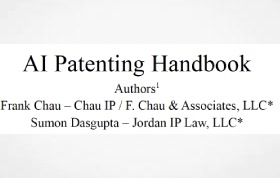The AI Patenting Handbook may be found here and covers various topics regarding Artificial Intelligence (AI) and patenting AI inventions. These include:
- AI Definitions and Technology Overview – This section provides a comprehensive overview of artificial intelligence (AI) definitions, categories, and technology. It introduces key concepts such as AI invention categories, AI architectures, and various AI types, including machine learning models, deep learning, and natural language processing. It’s aimed at grounding readers in the basic terminology and classifications used in AI technology and patenting.
- Drafting AI Patent Applications – This section focuses on the nuances of drafting patent applications for AI inventions. It covers conducting invention disclosure interviews, identifying the inventive subject matter, and crafting claims that are robust against challenges of subject matter eligibility and indefiniteness. The guide emphasizes the importance of describing the invention in detail, including its technical advantages, system inputs, and architecture, to strengthen the patent application.
- Prosecution and Enforcement – This section addresses strategies for navigating the patent prosecution process, particularly how to overcome rejections based on subject matter eligibility (§101) and provides insight into appeal decisions and court rulings relevant to AI patents. It highlights the importance of articulating the technical problem and solution, demonstrating the invention’s advancement over prior art, and the application of AI-specific prosecution strategies. Also, it discusses the significance of detectability and enforcement of AI patents, underscoring the challenges and considerations in defending AI-related intellectual property.
- Other Considerations – This section addresses additional aspects crucial for AI patenting, such as ethical considerations, the impact of AI inventions on societal norms and privacy, and the importance of adhering to data protection regulations. This section also explores the patentability criteria and considerations in different jurisdictions, including the EPO, Japan, China, Korea, and the UK, offering a global perspective on AI patenting. Lastly, it discusses AI inventorship issues, highlighting debates around AI as inventors, and touches on proposed legislation affecting AI patents.
If you would like a copy of the publication, please let me know. I look forward to working on this year’s upcoming paper to advance these topics further.
****
Subscribe to get updates to this post or to receive future posts from PatentNext. Start a discussion or reach out to the author, Ryan Phelan, at [email protected] (Tel: 312-474-6607). Connect with or follow Ryan on LinkedIn.




